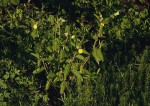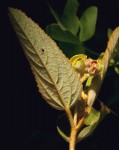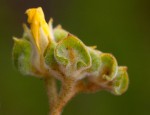| Home | > | List of families | > | Malvaceae: Byttnerioideae, Helicteroideae & Sterculioideae | > | Melhania | > | forbesii |
Melhania forbesii
Selected images: Click on each image to see a larger version and details of the record View all images (13)
Specimen citations: Display citations Detailed records: Display species records QDS maps by: Google Maps Point records by Google Maps
Species details: Click on each item to see an explanation of that item (Note: opens a new window)
| Synonyms: |
Melhania serrulata R.E. Fr. |
| Common names: | |
| Frequency: | Frequent |
| Status: | Native |
| Description: |
Branched shrubby herb up to c. 60 cm tall. All vegetative parts covered in greyish hairs, mixed with rusty brown stellate hairs, particularly on stems, petioles and veins on the udersides of leaves. Leaves up to 11 × 5 cm, oblong, ovate-oblong to ovate, somewhat discolorous; margin serrate or crenate; petioleup to 2.5 cm long. Flowers axillary, 1-3 together on pedunclesup to 9 cm long. Epicalyx bracts up to 1.5 × 1 cm, broadly ovate, pointed to slightly acuminate, densely greyish-white hairy. Sepals lanceolate, as long as or shorter than the epicalyx bracts. Petals broadly obovate, bright yellow. Style 1-3 mm long. Fruit slightly shorter than the sepals, ovoid, hairy. |
| Type location: |
Syntypes from Mozambique |
| Notes: | See the similar Melhania acuminata for comparison. |
| Derivation of specific name: | forbesii: named after John Forbes (1799-1823), an English plant collector and naturalist. As representative of the Horticultural Society of London he visited the Cape in 1822. He died on the Zambezi River in Mozambique the following year. |
| Habitat: | In drier types of open woodland. |
| Altitude range: | |
| Flowering time: | |
| Worldwide distribution: | Angola, Botswana, Namibia, Mozambique, Zambia, Zimbabwe and Limpopo, Mpumalanga, South Africa. |
| Zambian distribution (Flora Zambesiaca): | S |
| Zambian distribution (Provinces): | S |
| Growth form(s): | |
| Endemic status: | |
| Red data list status: | |
| Insects associated with this species: | |
| Spot characters: | Display spot characters for this species |
| Literature: |
Bandeira, S., Bolnick, D. & Barbosa, F. (2007). Wild Flowers of Southern Mozambique Universidade Eduardo Mondlane, Maputo, Mozambique Pages 106 - 107. (Includes a picture). Chapano, C. & Mamuto, M. (2003). Plants of the Chimanimani District National Herbarium and Botanic Garden, Zimbabwe Page 38. Chapano, C. & Mugarisanwa, N.H. (2003). Plants of the Matobo District National Herbarium and Botanic Garden, Zimbabwe Page 25. Da Silva, M.C., Izidine, S. & Amude, A.B. (2004). A preliminary checklist of the vascular plants of Mozambique. Southern African Botanical Diversity Network Report No. 30 Sabonet, Pretoria Page 112. Heath, A. & Heath, R. (2009). Field Guide to the Plants of Northern Botswana including the Okavango Delta Kew Publishing Page 312. (Includes a picture). Mapaura, A. & Timberlake, J. (eds) (2004). A checklist of Zimbabwean vascular plants Southern African Botanical Diversity Network Report No. 33 Sabonet, Pretoria and Harare Page 80. Phiri, P.S.M. (2005). A Checklist of Zambian Vascular Plants Southern African Botanical Diversity Network Report No. 32 Page 75. Pickering, H. & Roe, E. (2009). Wild Flowers of the Victoria Falls Area Helen Pickering, London Page 111. (Includes a picture). Setshogo, M.P. (2005). Preliminary checklist of the plants of Botswana. Sabonet Report no. 37. Sabonet, Pretoria and Gaborone Page 107. Timberlake, J.R. & Childes, S.L. (2004). Biodiversity of the Four Corners Area: Technical Reviews Volume Two (Chapter 5-15) Appendix 5-1: Plant Checklist Occasional Publications in Biodiversity 15 Page 227. Wild, H. (1960-1). Sterculiaceae Flora Zambesiaca 1(2) Pages 531 - 532. (Includes a picture). |
Other sources of information about Melhania forbesii:
Our websites:
Flora of Botswana: Melhania forbesiiFlora of Caprivi: Melhania forbesii
Flora of Mozambique: Melhania forbesii
Flora of Zimbabwe: Melhania forbesii
External websites:
African Plants: A Photo Guide (Senckenberg): Melhania forbesiiAfrican Plant Database: Melhania forbesii
BHL (Biodiversity Heritage Library): Melhania forbesii
EOL (Encyclopedia of Life): Melhania forbesii
GBIF (Global Biodiversity Information Facility): Melhania forbesii
Google: Web - Images - Scholar
iNaturalist: Melhania forbesii
IPNI (International Plant Names Index): Melhania forbesii
JSTOR Plant Science: Melhania forbesii
Mansfeld World Database of Agricultural and Horticultural Crops: Melhania forbesii
Plants of the World Online: Melhania forbesii
Tropicos: Melhania forbesii
Wikipedia: Melhania forbesii
| Home | > | List of families | > | Malvaceae: Byttnerioideae, Helicteroideae & Sterculioideae | > | Melhania | > | forbesii |





